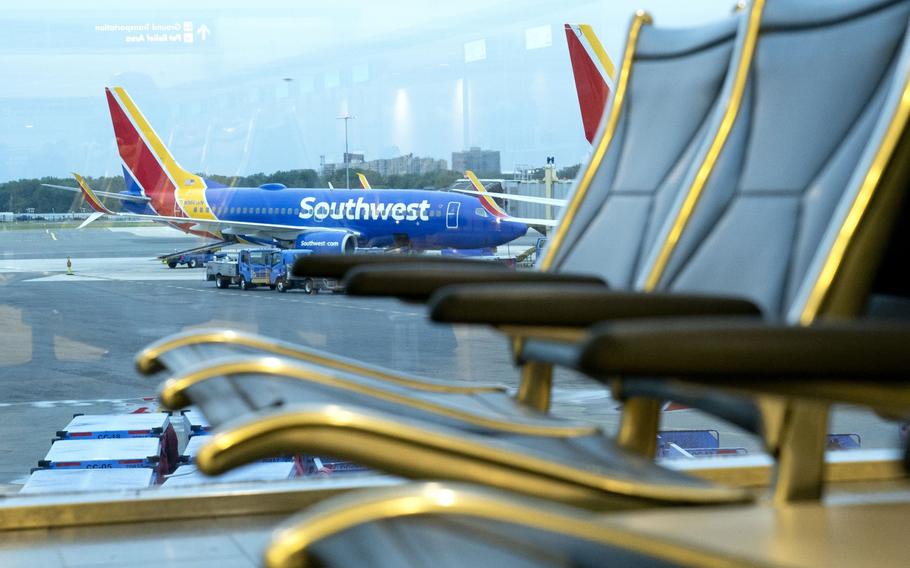Coronavirus
Vaccine passports keep Europe flying; the going is slower in China and the US
Bloomberg August 24, 2021

A Southwest Airlines plane at Ronald Reagan National Airport in Arlington in May 2021. (Stefani Reynolds/Bloomberg)
The delta variant of COVID-19 is scything through aviation just as key markets were getting back on their feet.
In the U.S., Southwest Airlines Co. is blaming the delta strain for a rash of canceled bookings and a slowdown in demand that may push it and several others to quarterly losses. After leading the industry’s recovery for much of last year, China is in retreat with airlines offering the fewest seats in six months as authorities attempt to stamp out an outbreak. Australia’s carriers are also in reverse with more than half of the country in lockdown.
“There is every chance the delta variant will dampen any recovery,” said John Grant, chief analyst with OAG. If there is progress, it will be “stop-start” as outbreaks make governments nervous about opening borders, he said.
A rare bright spot is Europe, the only place where so-called vaccine passports are widely used. The continent was an aviation laggard for most of 2020 as it floundered under infection waves, but airlines such as Ryanair Holdings Plc are now capitalizing on high inoculation rates and providing more flights.
Here’s how the highly contagious delta variant has affected major markets:
U.S.: Hopes are fading that a summer recovery, where passenger traffic reached 80% of pre-pandemic levels, will extend into the fall as a surge in infections spooks travelers and investors. The Bloomberg Americas Airlines Index last week tumbled 5.6% to its lowest level since February.
Southwest warned on Aug. 11 of a slowdown in bookings and rising cancellations, and said it will be difficult to replicate July’s profit over this quarter. Low-cost airlines Frontier Group Holdings Inc. and Spirit Airlines Inc. have also said they may report losses for the three months through September.
The delta variant is putting the brakes on corporate demand, too. Office reopening delays of up to 90 days are causing “a bit of a pause” in the recovery of domestic business travel, Delta Air Lines Chief Executive Officer Ed Bastian said in an interview with Fox Television on Aug. 9. The carrier is close to 50% of its 2019 level for U.S. business travelers.
China: Chinese airlines plan to operate 360,509 flights in August, the fewest since February, according to data from Cirium, which tracks air traffic. That follows the country’s latest COVID eradication campaign, which included traffic shutdowns at airports in places such as Nanjing, Beijing and Yangzhou. On Monday, China reported zero local transmissions, a promising sign that its slump in travel will be short-lived.
In an interview with Bloomberg Television on Monday, Hong Kong Commerce Secretary Edward Yau said COVID must be kept at bay before borders can fully reopen. The tight controls are piling pressure on the city’s Cathay Pacific Airways Ltd., which has suffered without a domestic market.
“It is extremely difficult to plan and operate with the constantly changing environment,” Cathay Chairman Patrick Healy said on Aug. 11, when the carrier reported a HK$7.6 billion ($976 million) first-half loss. Cathay’s shares rose 2.1% Tuesday morning in Hong Kong, trimming the year-to-date loss to 12%. They slumped 29% in 2020.
Europe: Freer borders and looser quarantine requirements are helping fill planes in Europe during the peak summer season, when carriers bring in revenue to see them through the winter months. Regional airline capacity is now about two-thirds of 2019 levels, compared with roughly a third as recently as April.
Discount airline Ryanair expects to post a profit this quarter and is opening 250 new routes for winter to keep the momentum going. Rival Wizz Air Holdings Plc sees capacity returning to pre-COVID levels this month, a feat few carriers anywhere have achieved.
Deutsche Lufthansa said in early August that North American routes could open up from late summer, with Asia following from the end of 2021. Air France-KLM has predicted a return to profit this quarter, when capacity will reach as much as 70% of normal levels.
Australia and New Zealand
A spiraling delta outbreak has thrust Qantas Airways’s recovery into reverse. New South Wales and Victoria, Australia’s two most populous states, are in lockdown as authorities rush to accelerate a sluggish vaccination program. The prolonged clampdown -- Sydney’s late-June lockdown runs until at least the end of September — has forced Qantas to furlough an additional 2,500 workers, taking the total to 9,500. Qantas’s domestic flying in July fell from 90% of pre-pandemic levels to less than 40%.
Air New Zealand is running a skeleton schedule of services after a nationwide lockdown was extended until Aug. 27. The restrictions follow the country’s first community COVID-19 case since February. New Zealand reported 35 cases Monday, taking the current outbreak to 107.